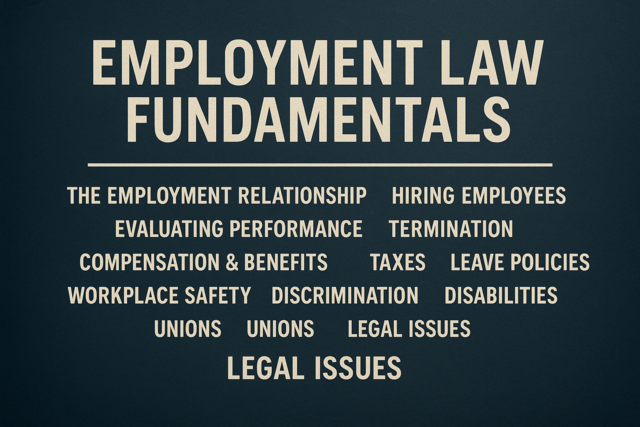Introduction
Sexual harassment is part of a larger body of law regarding discrimination. Our understanding of discrimination is evolving (and thankfully improving) all the time. While there is still a long way to go, the legal code helps us to understand others and eliminate discrimination in the workplace.
Know it
-
Children were not considered children, they were considered miniature adults (which is why child labor was acceptable and children always appeared unhappy in those black and white pictures).
-
Women and men had specific roles when it came to work and family and those lines were rarely crossed.
-
Slavery and servitude was a common and accepted practice, partly related to the idea of who was human and who wasn't as well as some definitions of a religious nature regarding who was "Christian" and who was "heathen".
-
Unfortunately, the list goes on...
Today, the walls that separate one person from another are being torn down with understanding and acceptance. Where once someone's skin color or gender were causes to delineate the differences, today those "differences" are considered minor and should even be celebrated.
These social changes are due in part to a balance between social attitudes and laws. Sometimes one is faster to act than the other. In the case of slavery, for example, sometimes social attitudes advanced first and understood that this was the mistreatment and discrimination of other human beings. Other times, the law needed to step in and make the change.
This article assumes that the attitudes within its readers is one of understanding a desire to eliminate discrimination. This section is about the laws that sometimes precede and sometimes follow.
Sexual harassment is part of the discrimination laws and discrimination is considered to be an issue ultimately about power: who holds the power over whom? This was true in the beginning of our understanding about sexual harassment. At first, sexual harassment was thought to primarily occur in situations where a boss made sex a part of the hiring or promoting process. It was thought that (in some cases) women would only succeed in business if they were required to sleep with their bosses. This part of sexual harassment is related to discrimination in that it is about power: one person (the male boss) having authority over a female subordinate. The view of sexual harassment, however, has widened to include other types of issues that are no longer necessarily about power but are now about respect.
-
Someone telling a coarse joke to another person (who may not appreciate the joke). The first person does not respect the other person's attitudes towards sex or sexual jokes.
-
Someone telling a coarse joke to another person and both people laugh, but a third person overhears and is uncomfortable. The first two people did not respect that there could have been others in the workplace who were uncomfortable with this type of joke.
-
A coworker making sexual advances toward another coworker.
-
An employee making sexual advances toward a customer.
-
A customer making sexual advances toward an employee.
Of course there are other examples but these common examples serve to show how sexual harassment is no longer an issue of power but of respect. (Note: Some might point out that the "power" issues are also respect issues. That may be true but discrimination is primarily a done in order to gain power over someone else so that is the inspiration behind the law).
For information and laws about sexual harassment from a Federal perspective, the site http://www.eeoc.gov/ provides a wealth of information. Specifically, you'll want to check out http://www.eeoc.gov/types/sexual_harassment.html.
Here is part of the legal regulations surrounding sexual harassment, found here:
[Code of Federal Regulations]
[Title 29, Volume 4]
[Revised as of July 1, 2001]
From the U.S. Government Printing Office via GPO Access
[CITE: 29CFR1604.11]
[Page 186-192]
TITLE 29--LABOR
CHAPTER XIV--EQUAL
EMPLOYMENT OPPORTUNITY
COMMISSION
PART 1604--GUIDELINES ON DISCRIMINATION BECAUSE OF SEX--Table of Contents
Sec. 1604.11 Sexual harassment.
(a) Harassment on the basis of sex is a violation of section 703 of title VII.<SUP>1</SUP>
Unwelcome sexual advances, requests for sexualfavors, and other verbal or physical conduct of a sexual nature
constitute sexual harassment when (1) submission to such conduct is made
either explicitly or implicitly a term or condition of an individual's
employment, (2) submission to or rejection of such conduct by an
individual is used as the basis for employment decisions affecting such
individual, or (3) such conduct has the purpose or effect of
unreasonably interfering with an individual's work performance or
creating an intimidating, hostile, or offensive working environment.
-
When that harassment becomes a condition of employment
-
When that harassment is used as a determining factor in employment decisions (such as hiring, promoting, etc.)
Both of these are "power" related laws. The third one is less about power and more about respect: -
When the conduct has the effect of interfering with work and creating an offensive working environment.
So, is it acceptable to mix sex and the workplace? Technically yes, providing that all three scenarios do not exist. For this reason, a relationship between coworkers (of the same level) will be considered more acceptable than a relationship between a subordinate and a supervisor. However, the relationship between coworkers needs to be done with discretion and taste or else others might feel that the third scenario applied.
(b) In determining whether alleged conduct constitutes sexual
harassment, the Commission will look at the record as a whole and at the
totality of the circumstances, such as the nature of the sexual advances
and the context in which the alleged incidents occurred. The
determination of the legality of a particular action will be made from
the facts, on a case by case basis.
This should be a comfort to everyone so that no one who conducts themselves properly in business needs to fear that an unwelcome and unwarranted charge against them will result in firing. This clause essentially suggests that all parties will (and should) be treated fairly and an investigation will be made rather than an immediate "jump-to-conclusion" witch hunt.
(c) [Reserved]
The law may be updated later and if so, this has been reserved for such an update. Likely it will be a matter of further definitions or a tightening of the definitions.
(d) With respect to conduct between fellow employees, an employer is
responsible for acts of sexual harassment in the workplace where the
employer (or its agents or supervisory employees) knows or should have
known of the conduct, unless it can show that it took immediate and
appropriate corrective action.
This is put in place to encourage employers to create an environment where sexual harassment cannot exist. Employers are held accountable if they do not properly act to resolve the situation.
(e) An employer may also be responsible for the acts of non-
employees, with respect to sexual harassment of employees in the
workplace, where the employer (or its agents or supervisory employees)
knows or should have known of the conduct and fails to take immediate
and appropriate corrective action. In reviewing these cases the
Commission will consider the extent of the employer's control and any
other legal responsibility which the employer may have with respect to
the conduct of such non-employees.
This also holds employers liable for conduct from outside parties upon their staff, including customers and vendors.
(f) Prevention is the best tool for the elimination of sexual
harassment. An employer should take all steps necessary to prevent
sexual harassment from occurring, such as affirmatively raising the
subject, expressing strong disapproval, developing appropriate
sanctions, informing employees of their right to raise and how to raise
the issue of harassment under title VII, and developing methods to
sensitize all concerned.
Showing that your company has created policies, a review panel, and mandatory training are three great ways to show how you comply with this part of the regulations.
(g) Other related practices: Where employment opportunities or
benefits are granted because of an individual's submission to the
employer's sexual advances or requests for sexual favors, the employer
may be held liable for unlawful sex discrimination against other persons who
were qualified for but denied that employment opportunity or benefit.
This part of the law was added to expand the definition outside of the employer / employee / customer / vendor realm and to protect those who are not connected with the company and (in particular) those who applied for a job but did not get it because someone else "slept their way into the job" in their place. The person who did not get the job could file a claim.
This is the first part of the regulations that stem from Title VII of the Civil Rights Act.
On a state-by-state level, no specific laws necessarily exist or need to exist: civil rights are a federal issue that should be applied equally to all Americans. Laws created by individual states rarely (if ever) supersede laws created by the federal government. The highest law of the land -- the federal courts -- are the final word on civil rights and more specifically on sexual harassment.
Searching for state specific information on sexual harassment will only result in finding the individual sexual harassment policies of state government departments.
However, the state does assist the EEOC with the state-specific Fair Employment Practices Agencies.
Apply it
Case Study: Two employees are involved in a mutually consenting relationship. They are professional and courteous about their relationship in the office and no one finds it offensive. In fact, some don't even know about it. The couple has opted to be open but tastefully discreet about their relationship. They even told human resources about it, just to be clear, but it has not been a problem in any way. One day, because of excellent on-the-job performance, one of those employees is promoted. The result is that the couple is now in a subordinate and superior position. Their relationship is strong and none of the other employees seem concerned at the moment. Should you do anything?
Answer: At this point things are fine and you probably don't HAVE to do anything. However, you should still consider transferring one of the two employees to a department in which there is not a subordinate / supervisory role. Not all relationships last forever and if their relationship broke down, you could be pulled into their break-up because one disgruntled lover feels jilted and decides to file a sexual harassment claim. (Yes, it happens). Or, if their relationship does continue, other employees may wonder about whether or not the workload is evenly distributed or any future promotions pass them over because of the pre-existing relationship. So you may be fine now and technically not in violation of any laws but in the future you could find yourself with a lawsuit if the relationship remains strong OR if the relationship breaks apart!
Think about it
-
Age discrimination -- young people: The age to join the military in many countries is between 16 and 18. However, the age to vote in many countries is around 18. The age to drink in many countries is between 19 and 21. So young people can fight for their country but cannot vote, marry, or drink. Or, young people can marry but cannot drink. While these may not necessarily be considered highly pressing issues, they do reveal a skewed understanding of age and reveal discrimination in some aspects against young people.
-
Age discrimination -- older people: People are living longer, healthier lives. Sometimes they want to work longer but cannot because of mandatory retirement restrictions. Other times they may be considered a burden on society once they reach a certain age. Of course, this view has no merit but reveals societal attitudes gone astray. The average age of the population is getting older so we'll see this area of discrimination come to the forefront very soon.
-
Middle-eastern descent: Because of the tragic events of 9/11 and later of terrorist acts in the London subway systems as well as military efforts in Afghanistan and Iraq, there is a growing bias against people who appear to be of Middle-eastern descent. Several cases have been reported around the world of people who appear Middle Eastern being forced off of airplanes by worried passengers. One such case involves a man of Spanish descent who simply has a long beard -- indicating that the issue is clearly a discriminatory issue based on assumptions. This is an area where laws may have to step in before societal attitudes change.
-
Receiving constant media attention also is the issue if gay and lesbian marriage and whether or not gay couples should receive the same rights as married couples. On the other side of this equation is the rights of religious groups to have opinions against gay and lesbian lifestyle.
In spite of our many social advancements, you can see that we are still faced with many cases of discrimination today in which social attitudes and laws have to step up to solve. While this article does not want to express sides on the issues, you need to determine your own stance and then carefully review whether or not you are allowing discriminatory biases to exist in your social circle. As well, consider whether there are other discrimination issues that exist in the community where you live.
Conclusion
Human rights is not a small issue! That is why the federal government has stepped in to make sure that people are treated fairly. While the states do assist to some degree, it is the federal government that legislates sexual harassment laws and is the last word on such. That said, it is everyone's responsibility to understand and obey these laws.

























